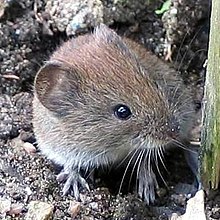Puumala virus
Puumala virus (PUUV) is the main cause of hemorrhagic fever with renal syndrome (HFRS) in Europe and Russia.
In its natural reservoir, PUUV causes a persistent infection with few symptoms and is spread through excretions, fighting, and grooming.
In humans, infection is usually asymptomatic but can lead to a mild form of HFRS often called nephropathia epidemica (NE).
Genome segments are encased in nucleoproteins to form ribonucleoprotein (RNP) complexes that are surrounded by a viral envelope that contains spikes emanating from its surface.
The virus was subsequently linked to a past outbreak among soldiers in Finland during World War Two, when the disease received the name nephropathia epidemica.
While infection is typically associated with HFRS, Puumala virus can cause hantavirus pulmonary syndrome on rare occasions.
The genome of Puumala virus is about 12 thousand nucleotides in length[2] and segmented into three negative-sense, single-stranded RNA (-ssRNA) strands.
[3] The small segment, about 1.83 kilobases (kb) in length,[2] encodes the viral nucleoprotein and a non-structural protein that inhibits interferon production.
The large segment, about 6.55 kb in length,[2] encodes the viral RNA-dependent RNA polymerase (RdRp), which is responsible for transcribing and replicating the genome.
[8][9] There are eight lineages of PUUV: Central European, Alpe-Adrian, Danish, South-Scandinavian, North-Scandinavian, Finnish, Russian, and Latvian.
[2] The Central European lineage is found in France, Belgium, Germany, Slovakia, and the Netherlands; Alpe-Adrian in Austria, Slovenia, Croatia, and Hungary; Danish in Denmark; South-Scandinavian in Norway and southern Sweden; North-Scandinavian in northern Sweden; Finnish in Finland, Karelia, and western Siberia; Russian in Estonia, Latvia, and central Russia; and Latvian in Latvia and northeast Poland.
Bank voles infected with PUUV have a lower winter survival rate than uninfected ones, possibly due to effects on metabolism.
[11] Transmission of Puumala virus occurs through inhalation of aerosols that contain saliva, urine, or feces, as well as through contaminated food, bites, and physical contact with bank vole excretions.
[13] Antibodies to Puumala virus have been detected in cattle, deer, and rabbits, but the role of these animals as hosts is unknown.
[14] When symptoms appear, PUUV usually causes a mild form of hemorrhagic fever with renal syndrome (HFRS) often called nephropathia epidemica (NE).
Early symptoms include fever, headache, lower back pain, nausea, vomiting, diarrhea, bloody stool, and the appearance of spots on the skin.
[12] Incidence of hantavirus infection in Europe has been growing over time[9] and is highest in Finland, where PUUV causes 1,000–3,000 HFRS cases yearly.
[11] The main risk factor for infection is visiting forested and suburban areas and, in the cold season, staying indoors during that time period.
[11] The case fatality rate from PUUV infection is low, at 0.08–0.4%,[11] and nearly everyone recovers fully without long term consequences.
[14] On rare occasions, individual cases and small clusters of hantavirus pulmonary syndrome have been observed in Europe[20] and in Turkey.
[21] PUUV infection is diagnosed based on observation of symptoms and testing for hantavirus nucleic acid, proteins, or hantavirus-specific antibodies.
This taxonomy is shown hereafter:[1][3][26] In 1942, an epidemic of disease occurred among soldiers in Salla, Eastern Lapland, Finland during the Second World War.
As with the 1942 epidemic, the outbreak mainly occurred in soldiers who lived in poor conditions such as trenches and wooden huts in forests.
